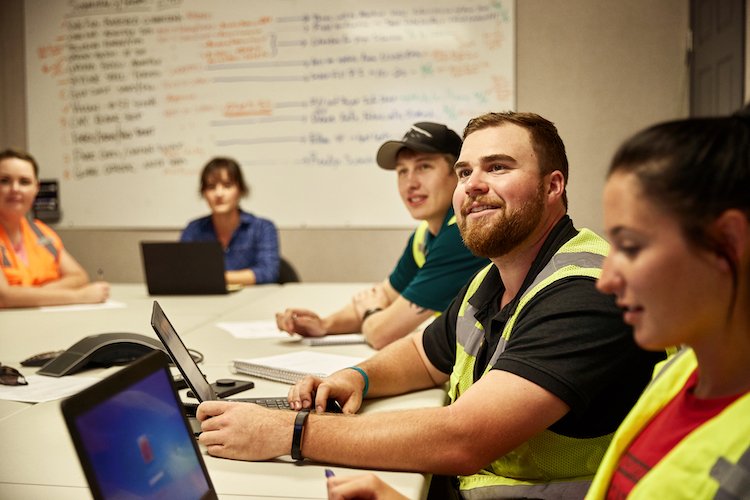Every team that starts a CMAR project wants the end result to be successful. So, why are some projects successful and others end with owners choosing to enact the off-ramp clause and terminate the contract? When an owner decides to pursue the off-ramp clause, it often means that a major disagreement with some aspect of the project has occurred—either the projected costs to construct the project are over the budget or the approach is not in alignment with the owner’s goals. Off-ramp provisions in contracts are essential to protecting owners, but when the off-ramp is enacted, the result is a delay in the overall project schedule and perhaps increased project costs.
So, why do owners enact the off-ramp provision? We have found that the main reasons are the underlying dynamics within the project team. If the project team dynamics have dissolved, it is frequently the result of a lack of trust among its members. A lack of trust is often the result of openness and transparency missing in the relationships. In order for a CMAR project to be successful, keeping these dynamics in mind when selecting all team members is critical. Successful project teams aren’t created by accident—they are created on purpose and require individuals who understand that a collaborative foundation of trust, openness, and transparency must exist among all participants.
TRUST
A commitment of trust needs to exist between each of the team participants (i.e., owner, engineer, & CMAR firm), which does not automatically occur. It is a process that evolves through communication and can begin as early as the procurement actions, such as with CMAR firms proposing on the project. Procurement procedures for a CMAR project allow the owner to learn more about the potential team members during the interview and make an initial determination as to the compatibility of the selected design engineer and CMAR firm they will ultimately hire to be part of the team. Once the CMAR firm is selected and the overall team established, the element of trust begins with all participants developing their working relationship and reaching agreement on decision-making milestones. During the first kick-off meeting with the owner’s team, design engineer, and CMAR firm, focus on answers to the questions below in order to reach agreement on a plan that fosters trust.
- What are the expectations of each team member?
- How will decisions be made, who will make them, and how will this be communicated?
- What process will the team use to resolve critical issues in the development of the project design and its costs, such as how to manage if the project goes over budget?
OPENNESS
An environment in which openness is a valued and important characteristic is one that provides team members with a comfort level to express opinions, ask questions, and explore opportunities that may not be immediately apparent. Each stakeholder is part of the team for a reason, which means that each brings important and different perspectives that are needed to provide sound solutions. For example, a recent project was over budget when it was 30% designed. The project team took a deep dive into the project’s priorities to determine how to bring it back on budget. During this investigation, they discovered that one of the items included in the scope was extensive coating repairs on existing chemical storage and metering areas. However, the team members openly acknowledged that they were unable to provide a solution to the problem. The CMAR team decided to bring in a third-party coating expert to review and evaluate the existing coatings. The outside expert found that in many areas the coatings were in very good condition and would not need to be replaced. The openness of the team members in acknowledging that there was no resident coating expert on the team allowed the CMAR to obtain an independent consultation, resulting in fewer repairs and a budget reduced by half. Teams that work together collaboratively like this find winning solutions. This reduces the likelihood that an owner will need to exercise the off-ramp clause and terminate the contract.
TRANSPARENCY
Transparency is a critical component of establishing trust among team members. For example, an owner should be transparent at the outset about the project budget and its limitations. This allows all team members to understand the owner’s expectations of the project and reach agreement on a plan to achieve them. As the engineers’ work on the design evolves, the CMAR team should also be transparent with the cost development. Every cost element requires back-up and a designated/ appropriate purpose. If there are concerns or unknowns regarding costs, then these items should be discussed as a team. This transparency builds trust among the members by knowing that the presented costs are the best estimate of true project costs at any given point in time. At the outset, the team should come to a consensus on the proper scope and contingencies. Similarly, the engineer should be transparent with the design components. This means openness with the CMAR and owner on the status of the design process and access to those performing the design. Design evolution gaps can be filled and constructability issues can be addressed continuously throughout the design phase in lieu of reconciling at design milestones. This helps to expedite the schedule, drive decisions, and create a more efficient process.
Just as a foundation needs to be properly built in order to support the weight of a building, a successful CMAR team needs a strong foundation of trust, openness, and transparency in order to allow it to overcome the challenges every project will encounter. Using these strategies will lead to a greater success rate and fewer off-ramps and bring more collaborative CMAR projects across the industry.

